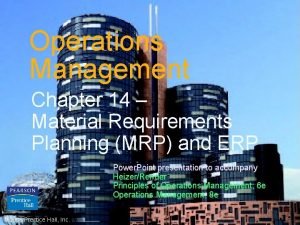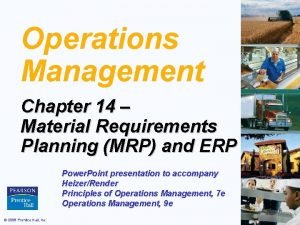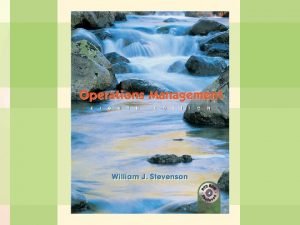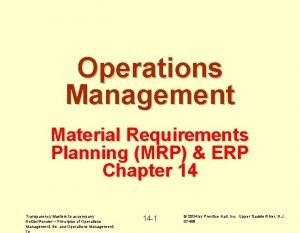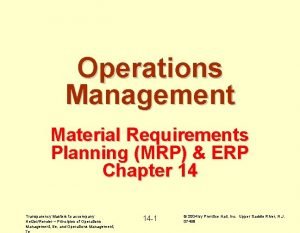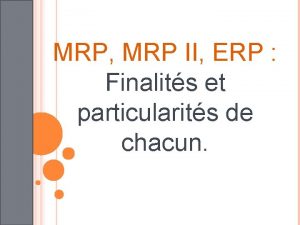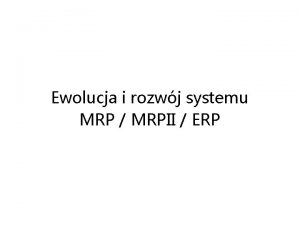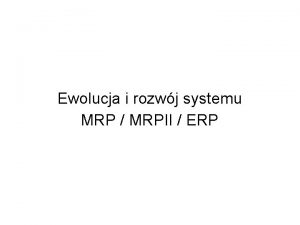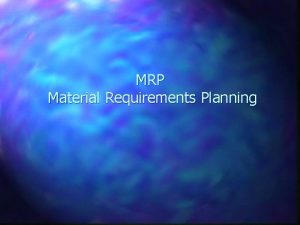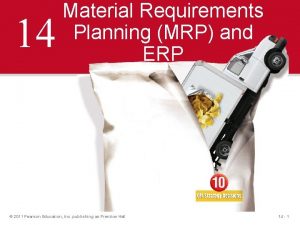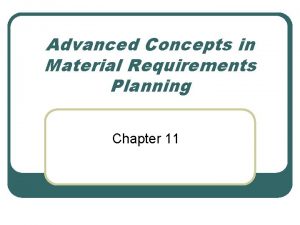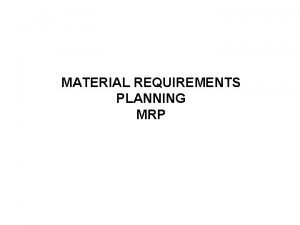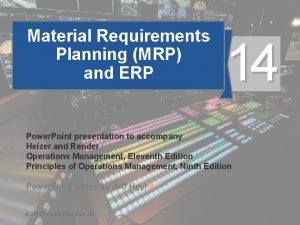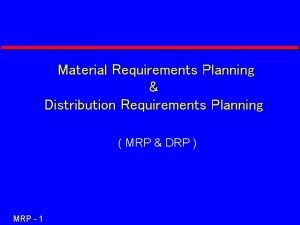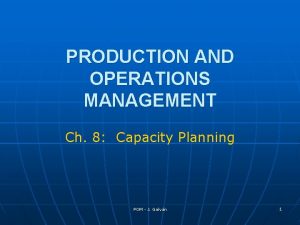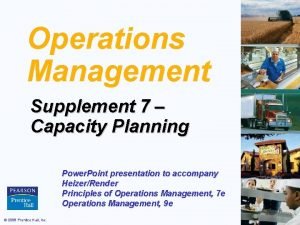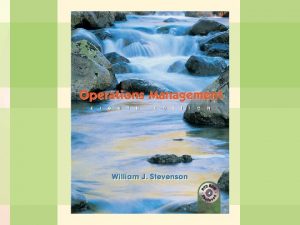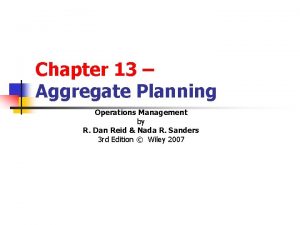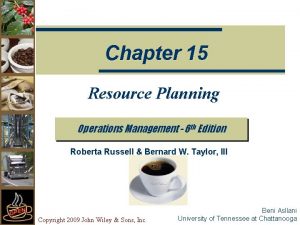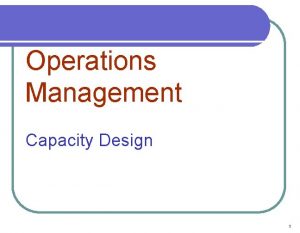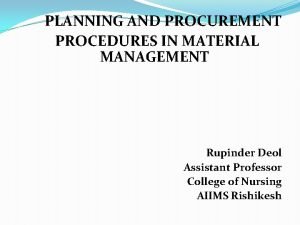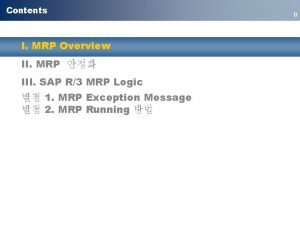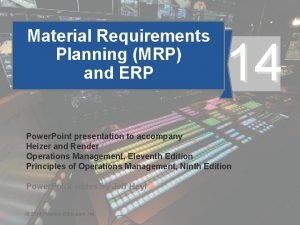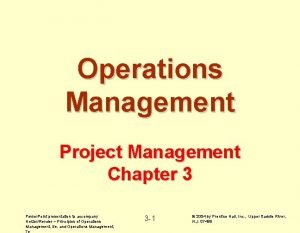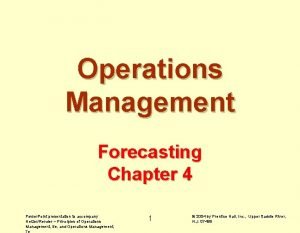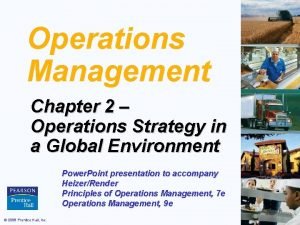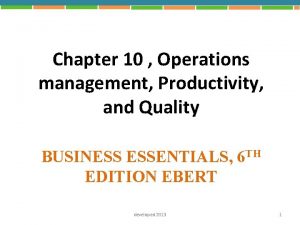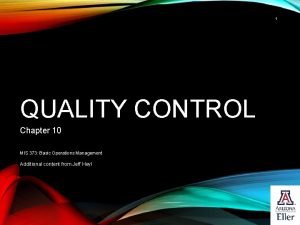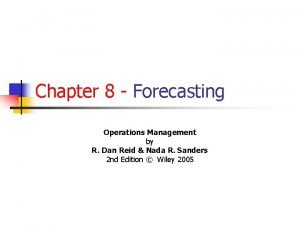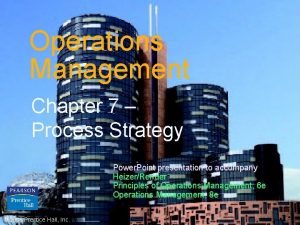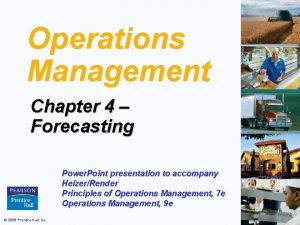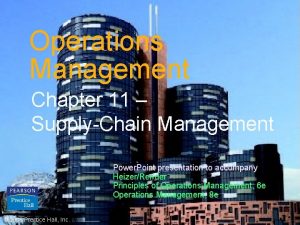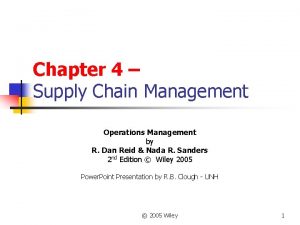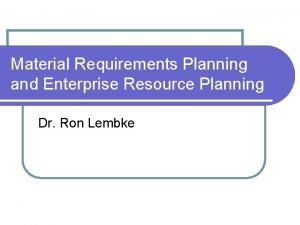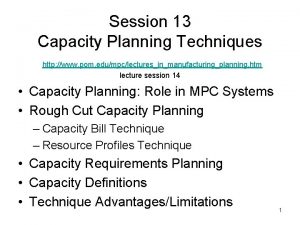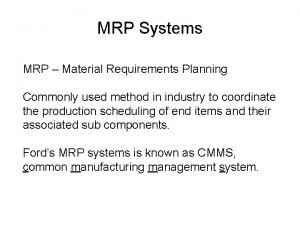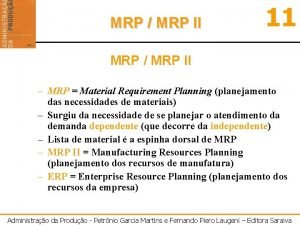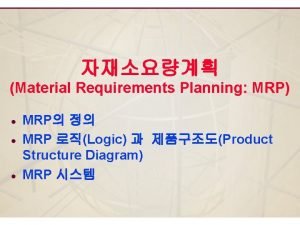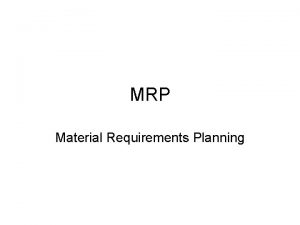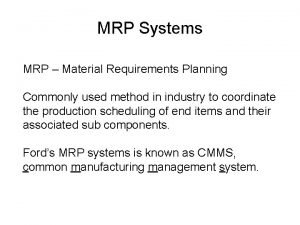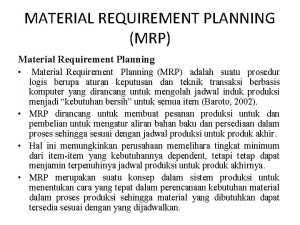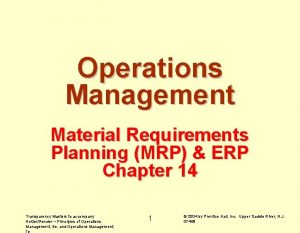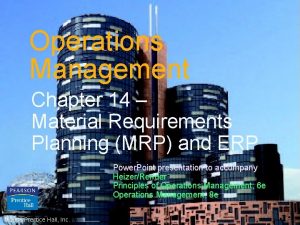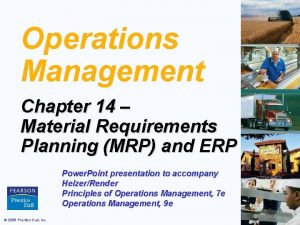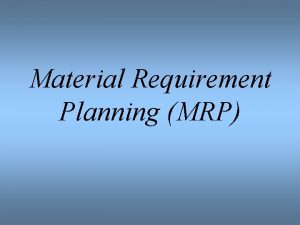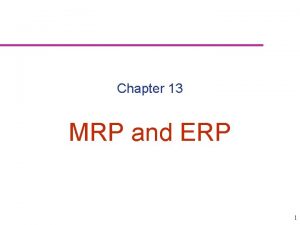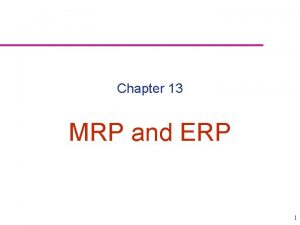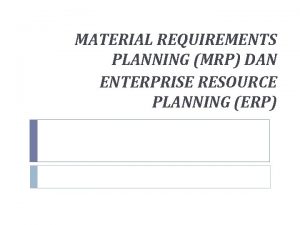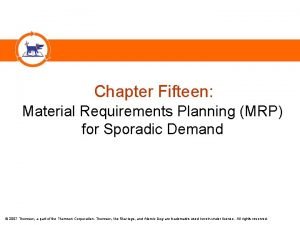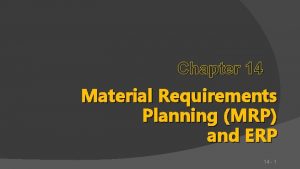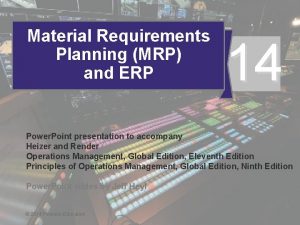Operations Management Chapter 14 Material Requirements Planning MRP





















































- Slides: 53

Operations Management Chapter 14 – Material Requirements Planning (MRP) and ERP Power. Point presentation to accompany Heizer/Render Principles of Operations Management, 7 e Operations Management, 9 e © 2008 Prentice Hall, Inc. 14 – 1

Benefits of MRP 1. Better response to customer orders 2. Faster response to market changes 3. Improved utilization of facilities and labor 4. Reduced inventory levels © 2008 Prentice Hall, Inc. 14 – 2

Dependent Demand þ The demand for one item is related to the demand for another item þ Given a quantity for the end item, the demand for all parts and components can be calculated þ In general, used whenever a schedule can be established for an item þ MRP is the common technique © 2008 Prentice Hall, Inc. 14 – 3

Prerequisites of MRP Effective use of dependent demand inventory models requires the following 1. 2. 3. 4. 5. © 2008 Prentice Hall, Inc. Master production schedule Specifications or bill of material Inventory availability Purchase orders outstanding Lead times 14 – 4

Master Production Schedule (MPS) þ þ Specifies what is to be made and when Must be in accordance with the aggregate production plan þ Inputs from financial plans, customer demand, engineering, supplier performance þ As the process moves from planning to execution, each step must be tested for feasibility þ The MPS is the result of the production planning process © 2008 Prentice Hall, Inc. 14 – 5

Master Production Schedule (MPS) þ MPS is established in terms of specific products þ Schedule must be followed for a reasonable length of time þ The MPS is quite often fixed or frozen in the near term part of the plan þ The MPS is a rolling schedule þ The MPS is a statement of what is to be produced, not a forecast of demand © 2008 Prentice Hall, Inc. 14 – 6

Aggregate Production Plan Months Aggregate Production Plan (Shows the total quantity of amplifiers) Weeks Master Production Schedule (Shows the specific type and quantity of amplifier to be produced 240 -watt amplifier 150 -watt amplifier 75 -watt amplifier 1 January February 1, 500 1, 200 2 100 3 4 100 500 6 100 500 300 5 7 8 100 450 100 Figure 14. 2 © 2008 Prentice Hall, Inc. 14 – 7

Bills of Material þ List of components, ingredients, and materials needed to make product þ Provides product structure þ Items above given level are called parents þ Items below given level are called children (component) © 2008 Prentice Hall, Inc. 14 – 8

BOM Example Level Product structure for “Awesome” (A) 0 A 1 2 3 12” Speaker kit w/ C(3) Std. amp-booster B(2) Std. 12” Speaker kit E(2) D(2) F(2) Std. 12” Speaker E(2) Packing box and installation kit of wire, bolts, and screws booster assembly G(1) D(2) Amp-booster 12” Speaker © 2008 Prentice Hall, Inc. 12” Speaker 14 – 9

BOM Example Level Product structure for “Awesome” (A) 0 A 1 2 3 D(2) Part B: 2 x number of As = (2)(50) = 100 12” Speaker 150 kit w/ C: 3 x number of As = (3)(50) BPart C(3) =Std. (2) Std. 12” Speaker kit amp-booster Part F: 2 x number of Cs = (2)(150) = 300 Part E: 2 x number of Bs + 2 x number of Cs = = 500 Speaker E(2)(2)(100) + (2)(150) F(2) Std. 12” booster assembly Part D: 2 x number of Bs + Packing 2 x number of Fs = (2)(100) + (2)(300) = 800 box and Part G: 1 installation x numberkitofof. Fs = (1)(300) 300 wire, G(1) = D(2) bolts, and screws Amp-booster 12” Speaker © 2008 Prentice Hall, Inc. 12” Speaker 14 – 10

Bills of Material þ Low-Level Coding þ Item is coded at the lowest level at which it occurs þ BOMs are processed one level at a time © 2008 Prentice Hall, Inc. 14 – 11

Accurate Records þ Accurate inventory records are absolutely required for MRP (or any dependent demand system) to operate correctly þ Generally MRP systems require 99% accuracy þ Outstanding purchase orders must accurately reflect quantities and scheduled receipts © 2008 Prentice Hall, Inc. 14 – 12

Lead Times þ The time required to purchase, produce, or assemble an item þ For production – the sum of the order, wait, move, setup, store, and run times þ For purchased items – the time between the recognition of a need and the availability of the item for production © 2008 Prentice Hall, Inc. 14 – 13

Time-Phased Product Structure Must have D and E completed here so production can begin on B Start production of D 1 week D 2 weeks to produce B 2 weeks E A 2 weeks 1 week E 1 week 2 weeks G C 3 weeks F 1 week D | | | 1 2 3 © 2008 Prentice Hall, Inc. | | 4 5 Time in weeks | | | 6 7 8 Figure 14. 4 14 – 14

MRP Structure Data Files Output Reports BOM MRP by period report Master production schedule MRP by date report Lead times Planned order report (Item master file) Inventory data Purchasing data Material requirement planning programs (computer and software) Purchase advice Exception reports Order early or late or not needed Order quantity too small or too large Figure 14. 5 © 2008 Prentice Hall, Inc. 14 – 15

Determining Gross Requirements þ Starts with a production schedule for the end item – 50 units of Item A in week 8 þ Using the lead time for the item, determine the week in which the order should be released – a 1 week lead time means the order for 50 units should be released in week 7 þ This step is often called “lead time offset” or “time phasing” © 2008 Prentice Hall, Inc. 14 – 16

Determining Gross Requirements þ From the BOM, every Item A requires 2 Item Bs – 100 Item Bs are required in week 7 to satisfy the order release for Item A þ The lead time for the Item B is 2 weeks – release an order for 100 units of Item B in week 5 þ The timing and quantity for component requirements are determined by the order release of the parent(s) © 2008 Prentice Hall, Inc. 14 – 17

Determining Gross Requirements þ The process continues through the entire BOM one level at a time – often called “explosion” þ By processing the BOM by level, items with multiple parents are only processed once, saving time and resources and reducing confusion þ Low-level coding ensures that each item appears at only one level in the BOM © 2008 Prentice Hall, Inc. 14 – 18

Gross Requirements Plan 1 A. Required date Order release date B. Required date Order release date C. Required date Order release date E. Required date Order release date F. Required date Order release date D. Required date Order release date G. Required date Order release date 2 3 Week 4 5 6 7 50 100 150 200 300 300 600 300 200 150 8 Lead Time 50 1 week 2 weeks 3 weeks 1 week 2 weeks Table 14. 3 © 2008 Prentice Hall, Inc. 14 – 19

Net Requirements Plan © 2008 Prentice Hall, Inc. 14 – 20

Net Requirements Plan © 2008 Prentice Hall, Inc. 14 – 21

Determining Net Requirements þ Starts with a production schedule for the end item – 50 units of Item A in week 8 þ Because there are 10 Item As on hand, only 40 are actually required – (net requirement) = (gross requirement - onhand inventory) þ The planned order receipt for Item A in week 8 is 40 units – 40 = 50 - 10 © 2008 Prentice Hall, Inc. 14 – 22

Determining Net Requirements þ Following the lead time offset procedure, the planned order release for Item A is now 40 units in week 7 þ The gross requirement for Item B is now 80 units in week 7 þ There are 15 units of Item B on hand, so the net requirement is 65 units in week 7 þ A planned order receipt of 65 units in week 7 generates a planned order release of 65 units in week 5 © 2008 Prentice Hall, Inc. 14 – 23

Determining Net Requirements þ A planned order receipt of 65 units in week 7 generates a planned order release of 65 units in week 5 þ The on-hand inventory record for Item B is updated to reflect the use of the 15 items in inventory and shows no on-hand inventory in week 8 þ This is referred to as the Gross-to-Net calculation and is the third basic function of the MRP process © 2008 Prentice Hall, Inc. 14 – 24

Net Requirements Plan The logic of net requirements Gross Allocations requirements + Total requirements – On Scheduled + hand receipts Net = requirements Available inventory © 2008 Prentice Hall, Inc. 14 – 25

Gross Requirements Schedule Figure 14. 6 S A B B C Lead time = 4 for A Master schedule for A Periods 5 6 7 40 Periods Gross requirements: B © 2008 Prentice Hall, Inc. 8 9 10 11 50 15 1 2 10 40+10 =50 3 40 C Lead time = 6 for S Master schedule for S 8 9 10 11 12 13 40 4 50 5 20 6 20 7 15+30 =45 30 8 Master schedule for B sold directly 1 2 3 10 10 Therefore, these are the gross requirements for B 14 – 26

Safety Stock þ BOMs, inventory records, purchase and production quantities may not be perfect þ Consideration of safety stock may be prudent þ Should be minimized and ultimately eliminated þ Typically built into projected onhand inventory © 2008 Prentice Hall, Inc. 14 – 27

Small Bucket Approach 1. MRP “buckets” are reduced to daily or hourly þ The most common planning period (time bucket) for MRP systems is weekly 2. Planned receipts are used internally to sequence production 3. Inventory is moved through the plant on a JIT basis 4. Completed products are moved to finished goods inventory which reduces required quantities for subsequent planned orders 5. Back flushing based on the BOM is used to deduct inventory that was used in production © 2008 Prentice Hall, Inc. 14 – 28

Lot-Sizing Techniques þ Lot-for-lot techniques order just what is required for production based on net requirements þ May not always be feasible þ If setup costs are high, lot-for-lot can be expensive þ Economic order quantity (EOQ) þ EOQ expects a known constant demand MRP systems often deal with unknown and variable demand © 2008 Prentice Hall, Inc. 14 – 29

Lot-Sizing Techniques þ Part Period Balancing (PPB) looks at future orders to determine most economic lot size þ The Wagner-Whitin algorithm is a complex dynamic programming technique þ Assumes a finite time horizon þ Effective, but computationally burdensome © 2008 Prentice Hall, Inc. 14 – 30

Lot-for-Lot Example Gross requirements 1 2 3 4 5 6 7 8 9 10 35 30 40 0 10 40 30 55 35 0 0 0 0 0 30 40 0 10 40 30 55 30 40 10 40 30 30 55 40 30 Scheduled receipts Projected on hand Net requirements 35 Planned order receipts Planned order releases 30 40 10 30 55 Holding cost = $1/week; Setup cost = $100; Lead time = 1 week © 2008 Prentice Hall, Inc. 14 – 31

Lot-for-Lot Example No on-hand inventory is carried through the system Total holding cost = $0 1 2 3 4 5 6 7 8 9 10 Gross 30 40 this 0 10 30 There are seven 35 setups for item 40 in this plan requirements Total setup cost = 7 x $100 = $700 Scheduled 55 receipts Projected on hand Net requirements 35 35 0 0 0 0 0 30 40 0 10 40 30 55 30 40 10 40 30 30 55 40 30 Planned order receipts Planned order releases 30 40 10 30 55 Holding cost = $1/week; Setup cost = $100; Lead time = 1 week © 2008 Prentice Hall, Inc. 14 – 32

EOQ Lot Size Example Gross requirements 1 2 3 4 5 6 7 8 9 10 35 30 40 0 10 40 30 55 35 0 43 3 3 66 26 69 69 39 0 30 0 0 7 0 4 0 0 16 Scheduled receipts Projected on hand Net requirements 35 Planned order receipts Planned order releases 73 73 Holding cost = $1/week; Setup cost = $100; Lead time = 1 week Average weekly gross requirements = 27; EOQ = 73 units © 2008 Prentice Hall, Inc. 14 – 33

EOQ Lot Size Example Annual demand = 27/week x 52 weeks = 1, 404 Total cost = setup cost + holding cost 1 2 3 4 5 6 7 9 10 Total cost = (1, 404/73) x $100 + (73/2) x ($1 x 852 weeks) Gross cost = $3, 798 Total 35 30 40 0 10 40 30 55 requirements Cost for 10 weeks = $3, 798 x (10 weeks/52 weeks) = Scheduled $730 receipts Projected on hand Net requirements 35 35 0 0 0 0 0 30 0 0 7 0 4 0 0 16 Planned order receipts Planned order releases 73 73 Holding cost = $1/week; Setup cost = $100; Lead time = 1 week Average weekly gross requirements = 27; EOQ = 73 units © 2008 Prentice Hall, Inc. 14 – 34

PPB Example Gross requirements 1 2 3 4 5 6 7 8 9 10 35 30 40 0 10 40 30 55 Scheduled receipts Projected on hand 35 Net requirements Planned order receipts Planned order releases Holding cost = $1/week; Setup cost = $100; Lead time = 1 week EPP = S/H = 100/1 = 100 units © 2008 Prentice Hall, Inc. 14 – 35

PPB Example Trial Lot Size (cumulative net requirements) Periods Combined 2 2, 3, 4 Gross requirements 2, 3, 4, 5, 6 Scheduled 30 70 1 70 35 80 120 receipts Combine periods Projected on 35 hand 6 Net requirements 6, 7, 8 order Planned receipts 6, 7, 8, 9 Planned order Combine releases 10 40 70 70 100 Part Periods 0 2 40 =3 40 x 41 5 6 40 30 40 0 10 40 70 = 40 x 1 + 10 x 3 230 = 40 x 1 + 10 x 3 + 40 x 4 Setup Costs Holding Total 7 8 9 10 30 55 100 + 70 = 170 2 - 5 as this results in the Part Period closest to the EPP 0 30 = 30 x 1 + 0 x 2 120 = 30 x 1 + 30 x 3 100 + 120 = 220 periods 6 - 9 as this results in the Part Period closest to the EPP 0 100 + 0 = 100 Holding cost = $1 /week; $100; + 190 = 490 Total cost Setup cost = 300 55 EPP = 100 units © 2008 Prentice Hall, Inc. 14 – 36

PPB Example Gross requirements 1 2 3 4 5 6 7 8 9 10 35 30 40 0 10 40 30 55 35 0 50 10 10 0 60 30 30 0 0 0 40 0 55 Scheduled receipts Projected on hand Net requirements 35 Planned order receipts Planned order releases 80 80 100 55 55 Holding cost = $1/week; Setup cost = $100; Lead time = 1 week EPP = 100 units © 2008 Prentice Hall, Inc. 14 – 37

Lot-Sizing Summary For these three examples Lot-for-lot EOQ PPB $700 $730 $490 a d e d l e i y e v a h d l u o w n i t i 5 5 4 $ f o Wagner-Wh t s co l a t o t a h t i plan w © 2008 Prentice Hall, Inc. 14 – 38

Lot-Sizing Summary þ In theory, lot sizes should be recomputed whenever there is a lot size or order quantity change þ In practice, this results in system nervousness and instability þ Lot-for-lot should be used when low-cost JIT can be achieved © 2008 Prentice Hall, Inc. 14 – 39

Lot-Sizing Summary þ Lot sizes can be modified to allow for scrap, process constraints, and purchase lots þ Use lot-sizing with care as it can cause considerable distortion of requirements at lower levels of the BOM þ When setup costs are significant and demand is reasonably smooth, PPB, Wagner-Whitin, or EOQ should give reasonable results © 2008 Prentice Hall, Inc. 14 – 40

Extensions of MRP þ Closed-Loop MRP þ MRP system provides input to the capacity plan, MPS, and production planning process þ Capacity Planning þ MRP system generates a load report which details capacity requirements þ This is used to drive the capacity planning process þ Changes pass back through the MRP system for rescheduling © 2008 Prentice Hall, Inc. 14 – 41

Material Requirements Planning II þ Once an MRP system is in place, inventory data can be augmented by other useful information þ Labor hours þ Material costs þ Capital costs þ Virtually any resource þ System is generally called MRP II or Material Resource Planning © 2008 Prentice Hall, Inc. 14 – 42

Smoothing Tactics 1. Overlapping þ Sends part of the work to following operations before the entire lot is complete þ Reduces lead time 2. Operations splitting þ Sends the lot to two different machines for the same operation þ Shorter throughput time but increased setup costs 3. Order or lot splitting þ Breaking up the order into smaller lots and running part ahead of schedule © 2008 Prentice Hall, Inc. 14 – 43

Enterprise Resource Planning (ERP) þ ERP modules include þ Basic MRP þ Finance þ Human resources þ þ © 2008 Prentice Hall, Inc. Supply chain management (SCM) Customer relationship management (CRM) 14 – 44

ERP and MRP Figure 14. 11 © 2008 Prentice Hall, Inc. 14 – 45

ERP and MRP Customer Relationship Management Invoicing Sales Order (order entry, product configuration, sales management) Shipping Distributors, retailers, and end users Figure 14. 11 © 2008 Prentice Hall, Inc. 14 – 46

ERP and MRP Master Production Schedule Inventory Management Bills of Material MRP Work Orders Purchasing and Lead Times Table 13. 6 Figure 14. 11 © 2008 Prentice Hall, Inc. Routings and Lead Times 14 – 47

ERP and MRP Supply Chain Management Vendor Communication (schedules, EDI, advanced shipping notice, e-commerce, etc. ) Figure 14. 11 © 2008 Prentice Hall, Inc. 14 – 48

ERP and MRP Finance/ Accounting Accounts Receivable General Ledger Accounts Payable Payroll Figure Table 14. 11 13. 6 © 2008 Prentice Hall, Inc. 14 – 49

Enterprise Resource Planning (ERP) þ ERP can be highly customized to meet specific business requirements þ Enterprise application integration software (EAI) allows ERP systems to be integrated with þ Warehouse management þ Logistics þ Electronic catalogs þ Quality management © 2008 Prentice Hall, Inc. 14 – 50

Enterprise Resource Planning (ERP) þ ERP systems have the potential to þ þ Reduce transaction costs Increase the speed and accuracy of information þ Facilitates a strategic emphasis on JIT systems and integration © 2008 Prentice Hall, Inc. 14 – 51

Advantages of ERP Systems 1. Provides integration of the supply chain, production, and administration 2. Creates commonality of databases 3. Can incorporate improved best processes 4. Increases communication and collaboration between business units and sites 5. Has an off-the-shelf software database 6. May provide a strategic advantage © 2008 Prentice Hall, Inc. 14 – 52

Disadvantages of ERP Systems 1. Is very expensive to purchase and even more so to customize 2. Implementation may require major changes in the company and its processes 3. Is so complex that many companies cannot adjust to it 4. Involves an ongoing, possibly never completed, process for implementation 5. Expertise is limited with ongoing staffing problems © 2008 Prentice Hall, Inc. 14 – 53
 Mrp 2 in operations management
Mrp 2 in operations management Mrp operations
Mrp operations Mrp 1 in operations management
Mrp 1 in operations management Mrp table
Mrp table Mrp and erp operations management
Mrp and erp operations management Mrp et erp
Mrp et erp Mrp a mrp ii
Mrp a mrp ii Pętla mrp
Pętla mrp Material requirements planning
Material requirements planning Material requirements planning
Material requirements planning Material requirements planning concepts
Material requirements planning concepts Material requirement planning calculation example
Material requirement planning calculation example Time phased product structure
Time phased product structure Net requirement planning
Net requirement planning Chapter 12 inventory management
Chapter 12 inventory management Capacity planning in operations management
Capacity planning in operations management Leading demand with incremental expansion
Leading demand with incremental expansion Location planning in operations management
Location planning in operations management Global retailing strategies
Global retailing strategies What is aggregate planning in operations management
What is aggregate planning in operations management Location planning in operations management
Location planning in operations management Resource planning in operations management
Resource planning in operations management Types of capacity planning in operations management
Types of capacity planning in operations management Material management planning and procurement
Material management planning and procurement Sap procurement type
Sap procurement type Auxiliary dental material
Auxiliary dental material Material requirement planning table
Material requirement planning table Operations and quality management
Operations and quality management Operations management with total quality management book
Operations management with total quality management book Gd and t symbols
Gd and t symbols Time variance
Time variance Non material culture definition
Non material culture definition Material and non material culture examples
Material and non material culture examples Non material culture examples
Non material culture examples Materials useful and harmful
Materials useful and harmful Operations management chapter 3 solutions
Operations management chapter 3 solutions Operations management chapter 4 forecasting solutions
Operations management chapter 4 forecasting solutions Global operations strategy options
Global operations strategy options Operations management introduction
Operations management introduction Process selection in operations management
Process selection in operations management Operations management chapter 10
Operations management chapter 10 Operations management chapter 10 quality control solutions
Operations management chapter 10 quality control solutions Chapter 8 operations management
Chapter 8 operations management Forecasting in operations management
Forecasting in operations management Crossover charts
Crossover charts Forecasting in operations management ppt
Forecasting in operations management ppt Chapter 11 operations management
Chapter 11 operations management What is job enrichment
What is job enrichment Chapter 4 operations management
Chapter 4 operations management Operation management chapter 2
Operation management chapter 2 Wedding planning requirements
Wedding planning requirements Enterprise requirements planning
Enterprise requirements planning Capacity requirements planning
Capacity requirements planning Capacity requirements planning
Capacity requirements planning
